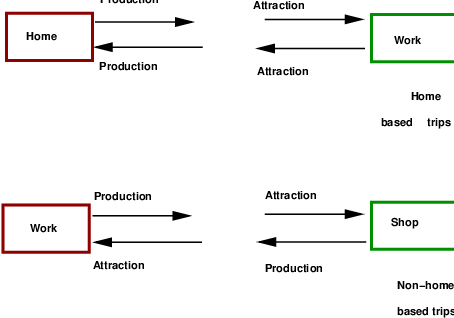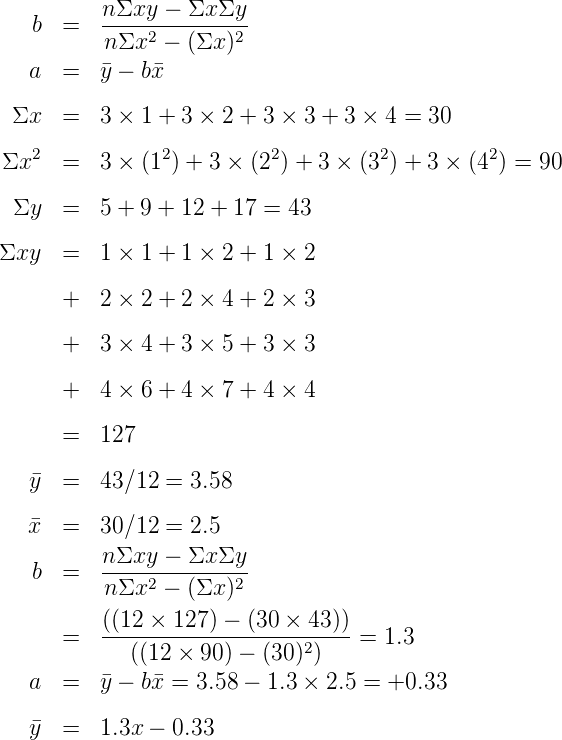
Trip generation is the first stage of the classical first generation aggregate travel demand model. The trip generation aims at predicting the total number of trips produced by and attracted to each zone of the study area. In other words, this stage answers the questions of how many trips originate at each zone from the household and socio-economic data. In this section, basic definitions, factors affecting trip generation, and two main modeling approaches; namely growth factor modeling and regression modeling are discussed.
Some basic definitions are appropriate before we address the classification of trips in detail. We will attempt to clarify the meaning of journey, home based trip, non home based trip, trip production, trip attraction and trip generation.
Journey is an out way movement from a point of origin to a point of destination, where as the word trip denotes an outward and return journey. If either origin or destination of a trip is the home of the trip maker then such trips are called home based trips and the rest of the trips are called non home based trips. Trip production is defined as all the trips of home based or as the origin of the non home based trips. See figure 1
Trips can be classified by trip purpose, trip time of the day, and by person type. Trip generation models are found to be accurate if separate models are used based on trip purpose. The trips can be classified based on the purpose of the journey as trips for work, trips for education, trips for shopping, trips for recreation and other trips. Among these the work and education trips are often referred as mandatory trips and the rest as discretionary trips. All the above trips are normally home based trips and constitute about 80 to 90 percent of trips. The rest of the trips namely non home based trips, being a small proportion are normally treated separately. The second way of classification is based on the time of the day when the trips are made. The broad classification is into peak trips and off peak trips. The third way of classification is based on the type of the individual who makes the trips. This is important since the travel behavior is highly influenced by the socio economic attribute of the traveler and are normally categorized based on the income level, vehicle ownership and house hold size.
The main factors affecting personal trip production include income, vehicle ownership, house hold structure and family size. In addition factors like value of land, residential density and accessibility are also considered for modeling at zonal levels. The trip attraction, on the other hand, is influenced by factors such as roofed space available for industrial, commercial and other services. At the zonal level employment and accessibility are also used. In trip generation modeling in addition to personal trips, freight trips are also of interest. Although the latter comprises only about 20 percent of trips, their contribution to the congestion is significant. Freight trips are influenced by number of employees, number of sales and area of commercial firms.
Growth factor modes tries to predict the number of trips produced or attracted by a house hold or zone as a linear function of explanatory variables. The models have the following basic equation:
 | (1) |
where Ti is the number of future trips in the zone and ti is the number of current trips in that zone and fi is a growth factor. The growth factor fi depends on the explanatory variable such as population (P) of the zone, average house hold income (I), average vehicle ownership (V ). The simplest form of fi is represented as follows
 | (2) |
where the subscript d denotes the design year and the subscript c denotes the current year.
A zone has 275 household with car and 275 household without car and let the average trip generation rates for each groups is respectively 5.0 and 2.5 trips per day. Assuming that in the future, all household will have a car, find the growth factor and future trips from that zone, assuming that the population and income remains constant.
 =
=  = 2.0.
= 2.0.
The above example also shows the limitation of growth factor method. If we think intuitively, the trip rate will remain same in the future. Therefore, the number of trips in the future will be 550 house holds × 5 trips per day = 2750 trips per day. It may be noted from the above example that the actual trips generated is much lower than the growth factor method. Therefore, growth factor models are normally used for qucik estimation and also in the prediction of external trips where no other methods are available. However, the regression methods are more suitable for internal trips and will be discussed in the following section.
The general form of a trip generation model is
 | (3) |
where xi’s are prediction factors or explanatory variable. The most common form of trip generation model is a linear function of the form
 | (4) |
where ai’s are the coefficient of the regression equation and can be obtained by doing regression analysis. The above equations are called multiple linear regression equation, and the solutions are tedious to obtain manually. However for the purpose of illustration, an example with one variable is given.
Let the trip rate of a zone is explained by the household size done from the field survey. It was found that the household size are 1, 2, 3 and 4. The trip rates of the corresponding household is as shown in the table below. Fit a linear equation relating trip rate and household size.
| Household size (x) | ||||||||||||||||||||||||||||||||||||||||||||||
|
Solution The linear equation will have the form y = bx + a where y is the trip rate, and x is the household size, a and b are the coefficients. For a best fit, b is given by

Trip generation forms the first step of four-stage travel modeling. It gives an idea about the total number of trips generated to and attracted from different zones in the study area. Growth factor modeling and regression methods can be used to predict the trips. They are discussed in detail in this chapter.
| Household size (x)
| ||||
| 1 | 2 | 3 | 4 | |
| Trips | 1 | 3 | 4 | 5 |
| per | 3 | 4 | 5 | 8 |
| day(y) | 3 | 5 | 7 | 8 |
| Descri- | House size (x1) | Income (x2)
| ||||||
| ption | 1 | 2 | 3 | 4 | 1 | 2 | 3 | 4 |
| Trips | 1 | 3 | 4 | 5 | 3 | 4 | 4 | 7 |
| per | 3 | 4 | 5 | 8 | 4 | 3 | 5 | 7 |
| day (y) | 3 | 5 | 7 | 8 | 3 | 5 | 6 | 8 |
I wish to thank several of my students and staff of NPTEL for their contribution in this lecture. I also appreciate your constructive feedback which may be sent to tvm@civil.iitb.ac.in
Prof. Tom V. Mathew
Department of Civil Engineering
Indian Institute of Technology Bombay, India
____________________________________________________________________________________________
Thu Jan 10 12:40:52 IST 2019